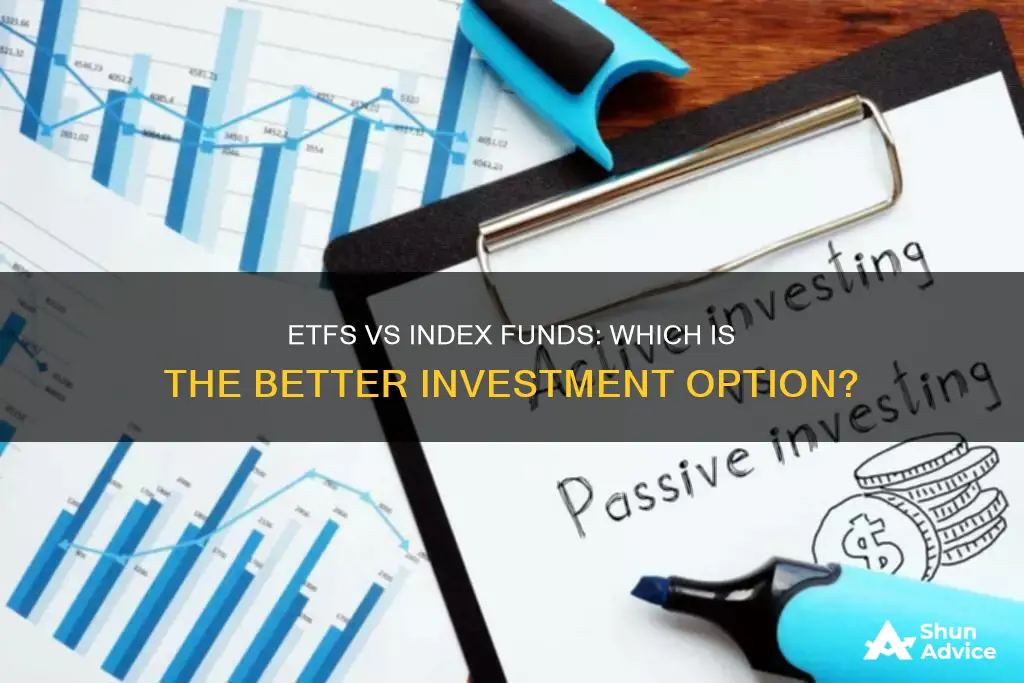
Exchange-traded funds (ETFs) and index funds are both great investment options for beginners and experts alike. They are similar in many ways, but there are a few key differences to note before deciding which is the better option for you.
ETFs and index funds are both large, professionally managed portfolios that pool money from many investors. They are often low-cost and passively managed, offering investors a set it and forget it solution. They also provide built-in diversification, allowing investors to spread their money across a wide range of stocks or other assets, thus reducing risk.
The biggest difference between the two is that ETFs can be traded throughout the day like stocks, whereas index funds can only be bought and sold at a set price at the end of the trading day. ETFs also tend to have lower minimum investments and are more tax-efficient than most index funds.
When deciding between the two, it's important to consider your investment goals and strategies. ETFs are generally better suited for frequent trading and intraday trading, while index funds are a good option for long-term investors who don't need to buy or sell throughout the trading day.
| Characteristics | Values |
|---|---|
| Trading Mechanism | ETFs can be traded throughout the day like stocks. Index funds can only be bought and sold at the end of the trading day. |
| Minimum Investment | ETFs have a lower minimum investment than index funds. |
| Capital Gains Taxes | ETFs are more tax-efficient than index funds. |
| Cost of Ownership | Both ETFs and index funds can be cheap to own, but ETFs may incur a bid-ask spread cost. |
| Trading Flexibility | ETFs offer more trading flexibility than index funds. |
| Liquidity | ETFs offer more liquidity than index funds. |
What You'll Learn
- ETFs can be traded throughout the day like stocks, but index funds can only be bought and sold at the end of the trading day
- ETFs may have lower minimum investments than index funds
- ETFs are more tax-efficient than index funds
- Both ETFs and index funds are low-cost investment options
- ETFs and index funds offer strong long-term returns

ETFs can be traded throughout the day like stocks, but index funds can only be bought and sold at the end of the trading day
One of the most significant differences between an index fund and an ETF is their tradability. ETFs can be traded throughout the day, much like stocks, whereas index funds can only be bought and sold at the end of the trading day. This means that the price of an ETF fluctuates constantly, while the price of an index fund changes only once a day.
This difference is important for investors who want to trade frequently. ETFs can be bought and sold at any time, making them ideal for active investors. Index funds, on the other hand, are more suitable for long-term investors who are not concerned with short-term price changes.
The ability to trade throughout the day also means that ETFs offer up-to-date information on the fund's investment value. In contrast, index funds only release this information after the market closes for the day.
Another key distinction is the minimum investment amount. ETFs typically have no minimum purchase requirements, allowing investors to buy as little as one share or even fractional shares. On the other hand, index funds often have higher minimums, which can range from a few thousand dollars to $10,000.
Trading commissions and load fees are other factors to consider. While many brokers have eliminated commissions for ETF trades, index funds can come with substantial trading commissions and load fees. Load fees, which are a form of sales commission, can be charged when buying or selling funds and can be a flat fee or a percentage of the transaction. ETFs do not have load fees.
In summary, ETFs offer more flexibility and accessibility to investors, particularly those who want to trade frequently and invest smaller amounts. Index funds, on the other hand, may be more suitable for long-term investors who are less concerned with intraday price changes and are able to meet the higher minimum investment requirements.
A Beginner's Guide to Mutual Fund Investing
You may want to see also

ETFs may have lower minimum investments than index funds
ETFs and index funds are both great investment options, but they have some differences that investors should be aware of. One notable difference is that ETFs may have lower minimum investments than index funds, making them more accessible to investors with smaller amounts of capital.
Minimum Investment Requirements
When investing in index funds, brokers often set minimum investment requirements, which can be significantly higher than the typical share price. These minimums can range from $1 to $3,000, posing a barrier for investors with limited funds. On the other hand, ETFs usually do not have such requirements, allowing investors to purchase as few as one share. Some brokers even offer fractional shares, making ETFs even more accessible.
Impact on Investment Strategies
The lower minimum investment requirements of ETFs can influence investment strategies. Investors with smaller amounts of capital can still gain exposure to a diverse range of securities by investing in ETFs. This flexibility enables investors to allocate their funds across various asset classes and sectors, potentially reducing risk and enhancing portfolio performance.
Comparison of Costs
While index funds may have higher minimum investments, it is important to consider the overall costs associated with each investment option. ETFs typically have lower expense ratios than actively managed mutual funds, making them a cost-effective option for long-term investors. However, it is worth noting that trading commissions and load fees may apply to both ETFs and index funds, impacting the overall cost of the investment.
Suitability for Different Investor Profiles
The lower minimum investment requirements of ETFs make them attractive to a broader range of investors. Those who are just starting their investment journey or have limited funds to invest may find ETFs more accessible. In contrast, index funds, with their higher minimums, may be more suitable for investors with larger investment portfolios or those focusing on long-term investments.
Importance of Conducting Thorough Research
When deciding between ETFs and index funds, investors should carefully consider their investment goals, risk tolerance, and financial situation. Conducting thorough research on the specific funds, understanding their investment strategies, fees, and historical performance, is crucial for making an informed decision.
Smart Mutual Fund Investing: Strategies for Success
You may want to see also

ETFs are more tax-efficient than index funds
While both ETFs and index funds are passively managed investment vehicles that pool investors' money into a basket of securities to track a market index, there are some key differences between the two. One of the main differences lies in their tax efficiency. Here are some paragraphs explaining why ETFs are considered more tax-efficient than index funds:
ETFs are known for their tax efficiency, which means they can help investors minimize their tax liabilities. This is mainly due to the fact that ETFs have fewer "taxable events" compared to index funds. When an investor wants to redeem shares in an ETF, they typically sell them on the stock market to another investor. On the other hand, when an investor wants to redeem an investment from an index fund, the fund manager may have to sell stocks to generate cash, triggering capital gains taxes for all investors holding the fund. This makes ETFs a more tax-efficient option for investors.
The tax efficiency of ETFs is further enhanced by their unique creation and redemption process. ETFs use "creation units" or baskets of assets to accommodate investment inflows and outflows, which minimizes the chances of an in-fund capital gains event. This structure helps to reduce the tax burden on investors, as they are not exposed to capital gains on individual securities within the ETF. Therefore, ETFs are designed to minimize taxes for investors, making them a more tax-efficient option compared to index funds.
Another reason why ETFs are considered more tax-efficient than index funds is the passive management of most ETFs. Passively managed ETFs have lower portfolio turnover as the portfolio only changes when there are changes to the underlying index it replicates. This results in fewer taxable events and, consequently, lower taxes for investors. Actively managed funds, on the other hand, experience more taxable events when selling the assets within them. Therefore, the passive management of ETFs contributes to their tax efficiency.
The structure of ETFs also plays a role in their tax efficiency. ETFs are traded on exchanges, just like stocks, and they use an "in-kind" creation and redemption process. This means that when an investor sells an ETF, they are typically selling it to another investor, and the transaction is settled directly between the two parties. As a result, the capital gains taxes on that sale are the responsibility of the selling investor alone. In contrast, index funds are bought directly from the fund manager, and redemptions may require the fund manager to sell holdings, triggering capital gains taxes for all investors.
Additionally, ETFs offer the advantage of lower minimum investments. Investors can often purchase as little as one share of an ETF, making it easier for those with limited funds to invest. This accessibility, combined with the tax efficiency of ETFs, makes them an attractive option for investors seeking to minimize their tax liabilities.
Retirement Funds: Investing in India's Future
You may want to see also

Both ETFs and index funds are low-cost investment options
The fees on both index funds and ETFs are low, especially when compared to actively managed funds. Many ETFs track an index, and this investment style keeps fees low. Since the fund changes based only on changes to the index – a passive approach – there are few labour costs associated with index funds. In 2022, the average expense ratio for index equity mutual funds was 0.05%, according to the Investment Company Institute’s latest report. For equity ETFs, it was 0.16%. On the other hand, the average fee in 2022 for actively managed mutual funds and ETFs was 0.66% and 0.68% respectively.
Index funds and most ETFs simply try to replicate an index of stocks or other assets. They don’t make active trading decisions and try to beat the market. Instead, they try to mimic the index and match its returns over time.
Index funds and ETFs are also similar in that they can be used as a passive investment strategy. For instance, you may have an employer-sponsored retirement plan that allows you to invest using payroll deductions. If you invest a certain percentage of your salary every pay period in index funds, your portfolio will need little to no ongoing maintenance.
The same is true if you invest in ETFs or index funds in a brokerage account. When you buy S&P 500 index funds, for example, most brokers offer the option to invest automatically.
Special Purpose Fund: A Guide to Investing Wisely
You may want to see also

ETFs and index funds offer strong long-term returns
ETFs and index funds are both great options for investors seeking strong long-term returns. Both investment vehicles aim to replicate the performance of a specific market index, such as the S&P 500 for large US stocks or the Bloomberg US Aggregate Bond Index for bonds. This passive investment strategy has proven effective over time, resulting in strong returns for investors.
The S&P 500, for instance, has historically returned an average of around 10% per year. While returns may vary from year to year, this level of performance means that, on average, your investment will double every 7.2 years. This makes ETFs and index funds solid long-term investment options.
Actively managed funds, on the other hand, have struggled to consistently outperform their benchmarks. Over the past 15 years, more than 87% of actively managed funds have underperformed their benchmarks, according to S&P Global. This highlights the advantages of passive investment strategies offered by ETFs and index funds.
Additionally, ETFs and index funds provide investors with broad diversification. By tracking a market index, these investment vehicles offer exposure to a wide range of securities, reducing the risk of significant losses from market swings. This diversification, combined with their low expense ratios, makes ETFs and index funds attractive options for long-term investors seeking strong and stable returns.
Unlocking Potential: Investing in the LFRIx Fund
You may want to see also
Frequently asked questions
ETFs can be traded throughout the day like stocks, whereas index funds can be bought and sold only for the price set at the end of the trading day.
ETFs generally have a lower minimum investment than index funds. ETFs can be bought for the price of a single share, and some brokers offer fractional shares. Index funds often have a minimum investment requirement, which can be a barrier for some investors.
ETFs are more tax-efficient than index funds. When you sell an index fund, the fund manager may have to sell securities to generate the cash to pay to you, and these sales can trigger capital gains taxes for all investors holding shares in the fund.
Both ETFs and index funds can be cheap to own, but ETFs may incur a bid-ask spread cost when buying or selling, and index funds may incur trading commissions and load fees.
Both ETFs and index funds offer instant diversification, low costs, and strong long-term returns. They are both passively managed, aiming to replicate the performance of a specific market index.







